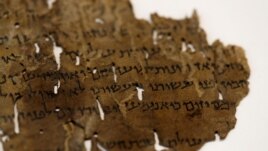06 June 2020
An international team of scientists has successfully decoded ancient DNA from animal skin on which some of the Dead Sea Scrolls were written.
The first of the 2000 year old religious documents were found in 1947 in a cave near Qumran, about 20 kilometers east of Jerusalem. Scientists since have gathered more than 25,000 pieces of writing on skin and ancient paper in the caves and other sites in the Judean Desert.
The University of Tel Aviv, the Israeli government and experts from Uppsala University in Sweden and Weill Cornell Medicine in New York City carried out DNA tests over seven years. They identified the kind of animal skins used for the documents. The finding will help experts to establish real scrolls from fakes.

A fragment from the Dead Sea Scrolls that underwent genetic sampling to shed light on the 2,000-year-old biblical trove is shown to Reuters at the Israel Antiquities Authority (IAA) laboratory in Jerusalem June 2, 2020. (REUTERS/Ronen Zvulun)
Many experts believe the scrolls were made by a small Jewish group called the Essenes. The Essenes had separated from the more traditional Jewish religion and were very secretive.
However, other experts argue that several people from different groups wrote the Dead Sea Scrolls. Those experts believe the scrolls were gathered together and put in the cave to keep them safe during a time of conflict.
The DNA tests show that the animal skin used for the writings was mainly from sheep common to the desert area. But, there were also some cow skin documents. The scientists say this suggests some documents may have been created in a city like Jerusalem, where cow raising was more common. Jews built a major religious center in the then Roman-ruled city around 2,500 years ago.
"The biological material of which the scrolls are made, is as telling and as informative as the content of the text," said researcher Noam Mizrahi. He is a professor of Bible studies at Tel Aviv University.
Study at the DNA laboratory in Uppsala showed the two versions of the document called the Book of Jeremiah were on cow skin. The scientists say the finding shows that these two documents were brought to Qumran from outside. They say the different versions also suggest that the understanding of Jewish religious writings differed.
Mizrahi said the Jewish community during the Second Temple appears to have been more diverse in religious understanding than researchers once thought.
The team of scientists tested extremely small pieces, even dust, of the scrolls. They say the same process could be used in the future to identify fake scrolls, like those found at The Museum of the Bible in Washington. Museum officials removed the documents in 2018, after discovering they were false.
I'm Susan Shand.
The Reuters News Agency reported this story. Susan Shand adapted it for Learning English. Caty Weaver was the editor.
_______________________________________________________________
Words in This Story
decode - v. to figure out an unknown language or system
fake - adj. not real, a copy
text – n. the written words